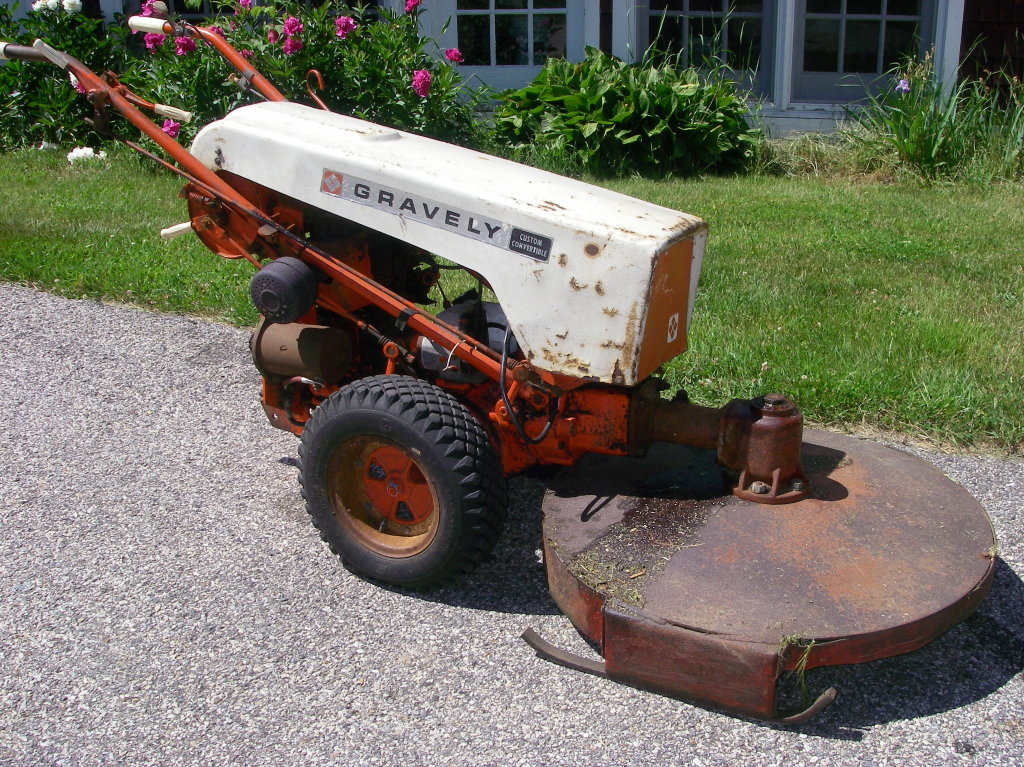Gravely tractors have been developed and marketed for extremely small farms, large gardens and grounds maintenance since the WWI era. Benjamin Gravely's original tractor was made in Dunbar, WV, with a single-cylinder gas engine turning a single driving wheel, with a cultivator rig attached behind, under the handlebars. The company continued in Dunbar into the 1960s, independent at first, and more recently changing ownership a number of times. Presently, Gravely International is a division of Ariens, located in Brillion, WI. Through 2004, they offered a two-wheel tractor and implements that were recognizably and largely compatible descendants of the Gravelys of the 1950s and 1960s. So far, parts availability is good.
Some people collect old Gravelys and implements, going right back to the original single-wheel units, to look at or show. I own them because I need to do various jobs around the place. The current conventional wisdom would have me own a whole lot of different gadgets, each with its own throw-away gas engine. Instead, I very much like the idea of a 4-stroke, pressure-lubricated power unit with lots of different implements to do the various jobs. After all, there's only one of me, and the time spent swapping implements isn't much compared to what I'd spend servicing four or five little engines each of which is only used three months a year.
One of mine was built in 1964, the other sometime in the 1970s. I prefer the older ones, with the Gravely engine instead of the Kohler, mostly because pressure oiling gives them a much longer lifespan. This vintage of Gravely is built like a farm tractor, enormously overdesigned compared to today's garden tractors. The Gravely tractor unit alone, without electric start, weighs more than 300 pounds. Implements like the sickle-bar or the 30 inch rotary are under 100 pounds, but something like my old snowblower is probably 130 pounds, with most of it out at the front. It's a great machine, but you can get into trouble trying to use it if you aren't large enough and strong enough to handle it (I would recommend 5 feet 4 inches and 150 pounds minimum). My sister is a little smaller than this, and she once had a bad time when the engine stalled in the middle of the road while she was snowblowing alone.
The Model L was manufactured in various configurations from around WWII into the 1970s. It uses a Gravely-built single cylinder side-valve engine, with magneto ignition. A cylinder head with an angled spark plug is usually rated at 6.6 HP, and a vertical spark plug indicates 7.6 HP. The operator either walks behind, steering via a pair of handlebars on which the controls are mounted, or rides on a two-wheel sulky. Implements are attached at the front of the chassis with four hex-head bolts. The dog clutch supplying power to the implement is part of the tractor, but the safety slip clutch is attached to the implement.
Early units had a planetary transmission which gave two speeds forward and two reverse. The transmission was available with three different gear ratios, in order to accomodate different implements' requirements. To go even slower, you could install optional gear-reduction wheels. Later, Gravely offered as an option another planetary, to provide 4 speeds forward and 4 reverse. This Model L8 with the Swiftamatic Transmission largely eliminated the need for gear-reduction wheels or different transmission gearing. Another useful option substituted a 12V battery and an electric starter for the manual pull-strap. Because it was optional, the electric start is independent of the magneto ignition, and doesn't have any charging system of its own - you need to re-charge it with an external charger every 10 or 20 starts, or every couple of months when it's idle. Post-1970 Gravelys have tractor-mounted studs in place of the top pair of implement attachment bolts, which greatly eases the process of getting the tractor and implement aligned.

L8 with electric start, 30 inch single-blade rotary mower mounted.
All of my Gravelys are L8s, with electric start and the optional governor. The one I use around the home place spends most of the Summer and Fall with a 40" two-blade lawn mower mounted, except for spells cultivating the garden with the rotary tiller, or mowing brush and tall weeds with either the 30" heavy-duty mower or the 48" sickle bar. As Winter approaches, I switch to my 1952-type square chute snowblower (with homebrew drift cutters) and put on the tire chains. Come Spring, there may be a little more brush clearing before I need to prepare the garden and start mowing the lawn again.
I'm slowly typing this in - sorry, no pictures
This was originally started around 1995 as the Model D and L Gravely Network by Craig Seabrook and Fred Kuntz, with a photocopied newsletter called Old Gravelys . It has since been re-organized as the Gravely Tractor Club of America, and publishes The Gazette quarterly. In the mid-2000s, this shifted from a color photocopied effort to glossy paper. They also organize summer get-togethers referred to as Mow-Ins. The GTCOA web site now has its own domain.